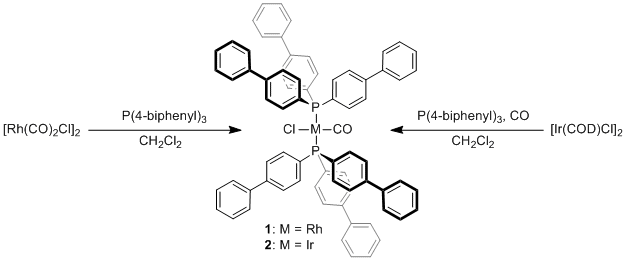Substitution at rhodium and iridium centres with a bulky phosphine
SyntheticPage 810
DOI:
Submitted: September 2, 2016, published: September 2, 2016
Authors
Adrian Chaplin (a.b.chaplin@warwick.ac.uk)
Richard Knighton (r.c.knighton@warwick.ac.uk)
Thibault Troadec (t.troadec@warwick.ac.uk)
A contribution from

Chemicals
Pentane
[Rh(CO)2Cl]2 (ref 1)
[Ir(COD)Cl]2 (ref 2)
P(4-biphenyl)3 (ref 3)
Procedure
trans-[Rh(P(4-biphenyl)3)2(CO)Cl] (1): A J. Young’s Flask was charged with [Rh(CO)2Cl]2 (30 mg, 0.077 mmol) and P(4-biphenyl)3 (151 mg, 0.309 mmol), and CH2Cl2 (4 mL) added at room temperature. The reaction mixture was stirred for 5 minutes and the solvent removed in vacuo. The resulting yellow powder was washed with pentane (2 x 3 mL), to afford the pure product as yellow solid (Yield = 168 mg, 95%). Crystals suitable for X-Ray diffraction analysis were grown by slow diffusion of pentane into a CH2Cl2 solution.
trans-[Ir(P(4-biphenyl)3)2(CO)Cl] (2): A J. Young’s Flask was charged with [Ir(COD)2Cl]2 (150 mg, 0.223 mmol) and P(4-biphenyl)3 (438 mg, 0.892 mmol), and CH2Cl2 (4 mL) added. The reaction mixture was freeze-pump-thaw degassed, placed under an atmosphere of CO and stirred for 5 minutes. The solvent removed in vacuo and the resulting yellow powder was washed with pentane (2 x 3 mL). Crystals suitable for X-Ray diffraction analysis were grown by slow diffusion of pentane into a CH2Cl2 solution (Yield = 453 mg, 82%).
Author Comments
Data
[Rh(P(4-biphenyl)3)2(CO)Cl] (1)
1H NMR (600 MHz, CD2Cl2) δ 7.90-7.95 (m, 12H), 7.72 (d, JHH = 8.0, 12H), 7.67 (d, JHH = 7.3, 12H), 7.47 (t, JHH = 7.3, 12H), 7.39 (t, JHH = 7.3, 6H). 13C{1H} NMR (151 MHz, CD2Cl2) δ 187.4 (dt, JRhC = 75, JPC = 16) 143.5 (s), 140.6 (s), 135.7 (t, JPC = 7), 132.3 (t, JPC = 23), 129.4 (s), 128.5 (s), 127.7 (s), 127.4 (t, JPC = 5). 31P{1H} NMR (243 MHz, CD2Cl2) δ 27.8 (JRhP = 126). Anal. Calcd for C73H54ClOP2Rh (1147.51 gmol-1): C, 76.41; H, 4.74. Found: C, 76.37; H, 4.82. IR (CH2Cl2, cm-1): ν(CO) 1978. The solid-state structure of this compound has been deposited with the Cambridge Crystallographic Data Centre under CCDC 1498191.
[Ir(P(4-biphenyl)3)2(CO)Cl] (2)
1H NMR (400 MHz, CD2Cl2) δ 7.94 (br d, JHH = 7.8, 12H), 7.67-7.82 (m, 24H), 7.37-7.55 (m, 18H). 13C{1H} NMR (101 MHz, CD2Cl2) δ 172.2 (t, JPC = 11), 143.7 (s), 140.5 (s), 135.9 (t, JPC = 6), 131.6 (t, JPC = 27), 129.5 (s), 128.5 (s), 127.8 (s), 127.4 (t, JPC = 5). 31P{1H} NMR (122 MHz, CD2Cl2) δ 22.8. Anal. Calcd for C73H54ClOP2Ir (1236.82 gmol-1): C, 70.89; H, 4.40. Found: C, 71.01; H, 4.60. IR (CH2Cl2, cm-1): ν(CO) 1965. The solid-state structure of this compound has been deposited with the Cambridge Crystallographic Data Centre under CCDC 1498192.
Lead Reference
Other References
http://dx.doi.org/10.1002/9780470132593.ch20
2. J. L. Herde, J. C. Lambert, C. V. Senoff, M. A. Cushing, Inorg. Synth. 1974, 15, 18–20.
http://dx.doi.org/10.1002/9780470132463.ch5
3. M. Joshaghani, E. Faramarzi, E. Rafiee, M. Daryanavard, J. Xiao, C. Baillie, J. Mol. Catal. A: Chem. 2006, 259, 35–40.
http://dx.doi.org/10.1016/j.molcata.2006.05.062
Keywords
carbonyl, chloride, iridium, organometallics, phosphine, rhodium